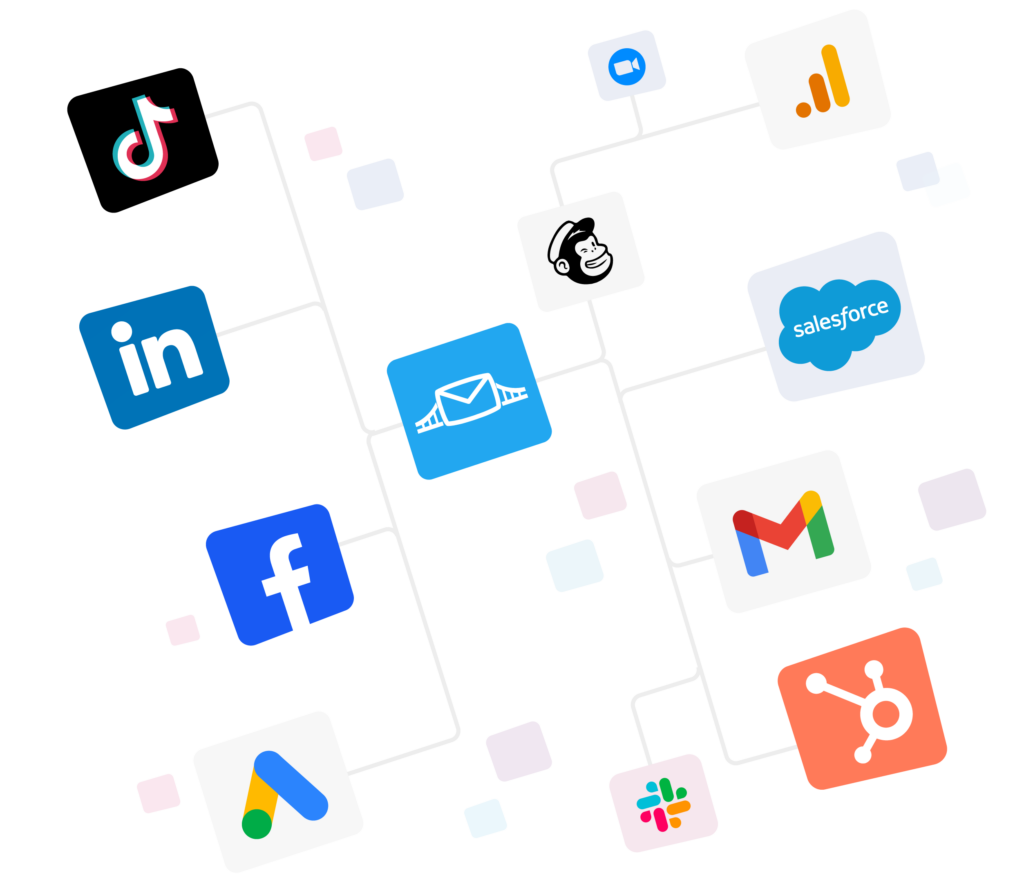
When you know the rules, you cut wasted time, prevent delivery issues, and protect your ad accounts from flags that quietly reduce reach.
Meta’s policies can even guide your creative strategy.
If you’re running your own ads, you don’t need to hire a lawyer. But you do need a checklist, a clean workflow, and a way to automate the boring parts so you can spend time on creative and offers.
In this article, we’ll cover everything about Facebook ad rules and strategies you can use to make the most of your Facebook lead generation, such as using automated data bridges.
How the Facebook Ad Review process actually works
- Two layers review your ad: automated checks first, human review if needed. Plan for both.
- Reviews are usually fast, but not instant: hours, sometimes longer during peak seasons. Build buffer time into launch plans.
- Edits retrigger review: duplicate a winning ad to test new copy; avoid editing the approved one mid-flight.
- Appeals can work: use the Request Review option with a calm, factual explanation and proof (e.g., certifications, disclaimers, licenses).
- Account trust compounds: consistent compliance reduces future friction; messy histories do the opposite.
- Policy isn’t static: bookmark Meta’s help center and refresh key pages before big pushes.
Here are some really helpful starting points: Meta’s ad policies and their ad copy cheat sheet.
Facebook ad rules that trip most advertisers (and what to do instead)
Before getting started, you should know what goes into the anatomy of a Facebook ad. Only then should you know how to make your ads compliant.
Let’s break it down by the three main content areas Facebook evaluates: copy, images, and video.
1. Facebook ad copy rules
Your ad should not have any misleading claims or exaggerated promises like ‘Lose 20 pounds in 10 days’, which will be rejected instantly.
Also, avoid direct personal attributes in targeting. For instance, instead of saying ‘Are you depressed?’ say, ‘Discover ways to improve your mood’.
No matter what, stay away from violating community standards and prohibited content categories. Anything promoting tobacco, weapons, unsafe supplements, or adult products is a no-go.
Copy-related Facebook ad rules also include limiting the use of capital letters, excessive punctuation, or clickbait.
2. Facebook ad image rules
Right off the bat, no before-and-after images for health/fitness, and no overly shocking or sensational visuals.
No one likes text overlays unless they are done really well. If you are going to use them, they should be minimal. Meta no longer enforces the strict 20% rule on Facebook, but too much text still affects performance.
This is probably an obvious one. You should avoid symbols or logos of other brands unless you have explicit permission.
Here’s a quick tip. Use Facebook’s Creative Hub to preview how your image will look across placements before submitting.
3. Facebook video ad rules
Flashing elements or overly fast transitions can be disruptive, so they are not recommended. Your ad’s audio must be clear, and preferably with captions for accessibility.
This one is really important, not just per Meta’s guidelines but also legal policies in a broader sense. Make sure to avoid shocking content, even if it’s contextually relevant.
Lastly, make sure all claims that are made in the video meet copy guidelines.
What goes into a good video ad?
Pre-checks for compliance with Facebook ad rules
This is a 10-minute checklist that will save you hours. Let’s take a quick look:
- Map the category. Is this General, Special (credit/employment/housing), or Social Issues/Politics?
- Run the attribute sweep. Remove any copy that calls out personal traits, health status, financial status, or identity.
- Cut guarantees. Replace absolutes with measurable, plausible outcomes + disclaimers.
- Swap visuals. Replace before/after, shock, or deceptive UI with clean product/lifestyle frames.
- Check targeting. For Special Ad Categories, use the mandated targeting options only.
- Add proof. If you reference numbers, keep your source/documentation handy.
- Accessibility pass. Legible fonts, strong contrast, captions on video.
- Landing page alignment. Claims, pricing, and offers match the ad; no bait-and-switch.
- Label regulated content. Include licenses, approvals, or disclaimers where required.
- Stage the appeal. Save a short note explaining compliance, in case you need a manual review.
Make the most of Meta campaigns with automation via LeadsBridge
Policy compliance keeps your ads live. However, your ad needs to be scalable and profitable. LeadsBridge is built for advertisers, so the integrations do what media buyers actually need.
What LeadsBridge offers you:
- Real-time Lead Sync from your lead ads to your CRM or autoresponder.
Using automated data bridges to route new leads instantly to the right pipeline and trigger SMS/email sequences while intent is high.
Learn how to do it in 3 steps by downloading leads from Facebook lead ads.
- Audience Sync (evergreen, consent-based audiences).
Build segments once and let the data bridge do its thing to keep them fresh automatically. Retarget warm prospects and exclude recent purchasers to reduce waste and improve ROAS.
Looking for more strategy ideas? Learn about the Facebook ads funnel and Meta ads best practices.
- Meta Conversions API (server-side events from your CRM).
Feed high-quality first-party data back to Meta for better attribution and optimization. The data from Meta Conversions API is especially important to post-privacy changes.
Do Facebook ads work for small businesses? You should always consider the broader impact they have on your business category.
- Facebook Conversion Leads optimization goal integrated via LeadsBridge.
When you switch your Lead Ad’s Optimization & Delivery setting from Leads to Conversion Leads performance goal, Meta’s algorithm looks for people who are statistically most likely to become paying customers.
However, you’ll need to feed Meta with always-updated data to make this happen.
This data helps you get higher lead quality at roughly the same (or lower) CPA, plus a feedback loop that keeps improving as your sales data grows.
Step-by-step guide to setting up automation
Step 1: Start with lead capture.
Run a compliant lead ad.
Step 2: Set up instant sync.
Use LeadsBridge to push leads to your CRM in real time and tag by offer, audience, and funnel stage.

You can essentially connect Facebook lead ads to any marketing platform with LeadsBridge. The best part is that you can do this in a few simple clicks without knowing how to code.
Step 3: Review event feedback.
Implement another integration set to send Qualified, Opportunity, and Closed-Won events back to Meta via the Conversions API.
Step 4: Consider audience refinement.
Not getting the results that you are looking for? Use Audience Sync to retarget form starters, exclude recent buyers, and build lookalikes from high-value segments.
Step 5: Create a ROAS feedback loop.
Optimize bids and creative using server-side conversion data, not vanity metrics.
As you grow, you need to move toward better optimization signals, smaller audiences with higher intent, and less budget wasted on people who just converted.
As soon as you have established a solid advertising foundation, consider Conversion leads optimization performance goal.
But what can really set you apart from the rest is LeadsBridge Performance Booster. A feature that’s exclusive to LeadsBridge users.
Meta usually has no idea about the leads’ precise journey after they hit submit. Performance Booster closes the loop by telling Meta who books a call, signs up, or vanishes. The algorithm then learns to chase converters and filter out the click-and-leave browsers.
Final takeaway
Facebook ad rules are a framework for building ads that users trust and the algorithm loves.
By understanding the guidelines and automating your workflow with tools like LeadsBridge, you can protect your campaigns from rejection and even improve your ROI.
Ready to run Facebook ads with outstanding efficiency? Discover Facebook lead ads integration and start syncing leads in real time today.





















